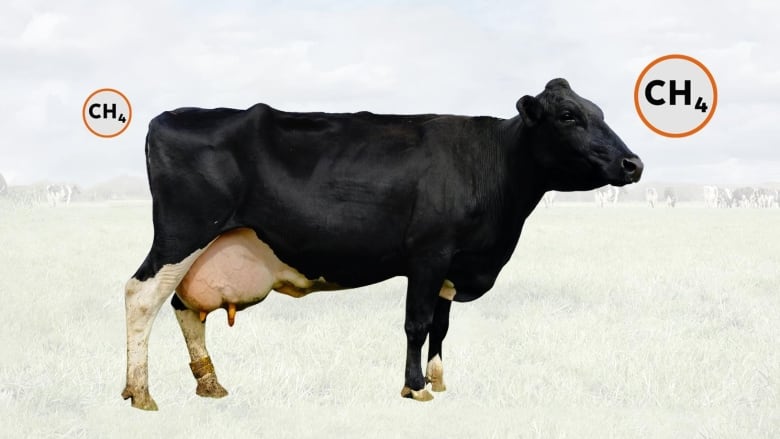Canada has pledged to reduce methane emissions — here are some ways to get there
Agriculture and oil and gas industries are key drivers of methane emissions

Our planet is changing. So is our journalism. This story is part of a CBC News initiative entitled Our Changing Planet to show and explain the effects of climate change and what is being done about it.
At the COP26 climate conference in Glasgow, Scotland, earlier this week, U.S. President Joe Biden announced a far-reaching plan to reduce methane emissions worldwide.

This echoed a pledge in October by the U.S., Canada and more than 80 other countries to reduce methane emissions by at least 30 per cent of 2020 levels by 2030.
As far as greenhouse gases go, methane — whose molecular makeup is one atom of carbon and four atoms of hydrogen, or CH4 — stays in the atmosphere for a shorter period of time but traps more heat.
According to the federal government's official greenhouse gas inventory, methane accounts for 13 per cent of Canada's GHG emissions, although a recent study suggests that methane emissions are likely one and a half times higher than current estimates.
- Have questions about COP26 or climate science, policy or politics? Email us: ask@cbc.ca. Your input helps inform our coverage.
To meet these methane reduction goals, new technology is emerging in two sectors that are primarily responsible for methane emissions in Canada: agriculture and oil and gas.
WATCH | World leaders promise to curb methane emissions:
Canada's greenhouse gases: a breakdown

Agriculture
Nearly 30 per cent of methane emissions come from the agricultural sector, where methane accounts for more emissions than any other GHG, according to Canada's greenhouse gas inventory.
Cattle burps make up a significant portion of these emissions. Karen Beauchemin, a researcher with Agriculture and Agri-Foods Canada who is exploring ways to reduce these emissions, says roughly a third of all GHG emissions from the agricultural sector come from the digestive activities of cattle. That's more than three per cent of Canada's overall GHG emissions.
How cows produce methane

"If the sector wants to improve," said Beauchemin, "we need to decrease livestock numbers or we need to decrease the emissions from those animals."
Mixing additives like sunflower oil into cattle feed can reduce their emissions by around 15 per cent, and an additive called 3-nitrooxypropanol (3-NOP) is shown to reduce methane emissions in cattle by an average of 30 per cent, according to Beauchemin's research. But 3-NOP has not been approved in Canada, and Beauchemin says the regulatory system prevents these additives from being approved in a timely manner.
"There's definitely ways of reducing methane emissions by 15, 20 per cent," said Beauchemin. "But those additives that are going to bring 30 and 40 and 50 per cent reductions are still [stuck] in the pipeline."
Capturing methane for energy use

Methane is also released from manure, which is used on farms to fertilize crops.
There are two ways to deal with these emissions: reduce or harness them. Emissions can be reduced by covering manure pools with straw, or by altering the acidity of the manure to deactivate the micro-organisms that produce methane.
Andrew VanderZaag, who researches methane emissions on farms, says at least 30 farmers in Canada are capturing methane from manure storage systems and selling it to energy companies.
"They are able to reduce the methane emissions from their manure management system to very, very low [levels]," he said. "They're producing renewable natural gas for the [energy] grid, so there's that benefit from that side as well."
Oil and gas
According to public data compiled by Our World in Data, around 40 per cent of Canada's methane emissions are attributed to the oil and gas sector. These emissions can be intentional or as a result of leaks, either in orphaned wells or in the machinery used to process oil and gas. Methane gas is also vented off intentionally as a byproduct of petroleum refinement.
Plugging an orphaned well

But methane is a sneaky gas: it's odourless and colourless, meaning it often escapes unnoticed into the atmosphere.
Jackson Hegland, the executive director of the Methane Emissions Leadership Alliance, a Calgary-based organization that helps connect oil and gas companies to technology that reduces their methane emissions, says detection is one of the most pressing challenges.
"Leak detection is critical, and this is where there's a lot of innovation happening," said Hegland.
He said until just a few years ago, the best detection method was a handheld infrared camera that could see gas escaping from facilities.

Hegland added that because vented methane tends to be low-pressure, measuring how much gas is released is a challenge.
LiDAR is a technology that can pinpoint leaks and measure methane leaks with far more accuracy than traditional handheld equipment. LiDAR uses laser beams to visualize an area, much like sonar uses sound waves. Companies like Bridger Photonics are using plane-mounted LiDAR to map entire oil and gas production systems for companies in the U.S. and Canada.
How LiDAR can detect methane emissions:
Currently, regulations in Canada specify that companies must inspect for methane leaks three times per year and patch them right away, which is largely done using ground crews with infrared cameras.
Pete Roos, CEO of Bridger Photonics, says their LiDAR technology is effective, but that they're still working on making sure it satisfies requirements.
"Once you get the regulations to allow this," said Roos, "there's no stopping it. It will be done on every site."
Even so, once a scan is complete, it's up to the company to repair the leaks.
"The technology exists today to fix the problem on the detection side," said Roos. "The harder part is the repair portion."
Corrections
- A previous version of this story said that at least 30 farmers in B.C. are capturing methane. In fact, it is more than 30 farmers across Canada.Nov 04, 2021 2:15 PM ET



